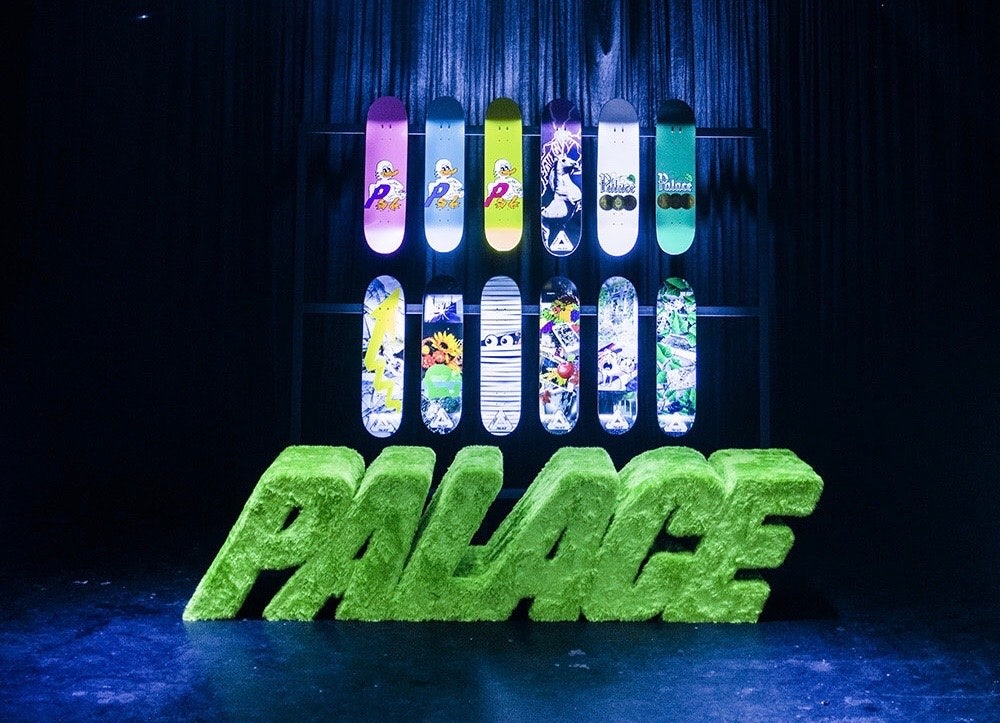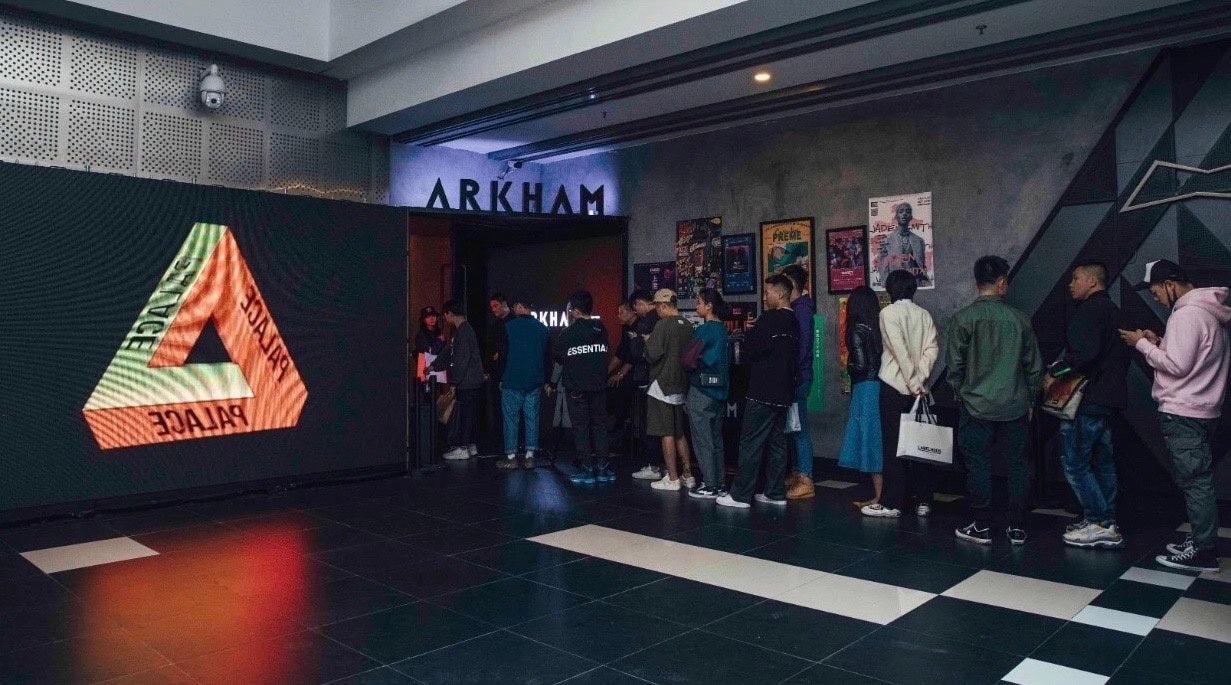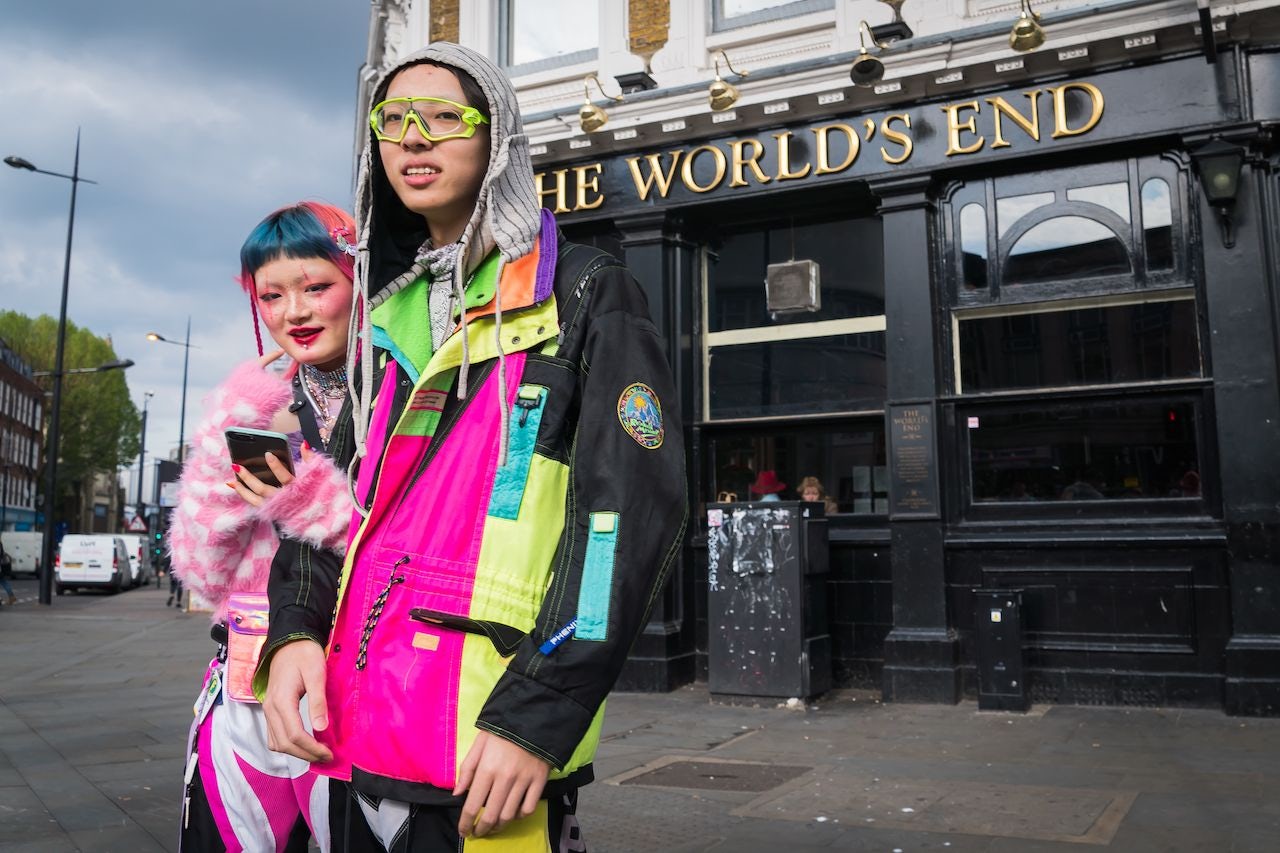Arkham Club, Shanghai — a home for local underground electronic music and live parties was bustling with a long line of streetwear-savvy youths over the weekend. The reason? A cultish, London-born skateboard shop and streetwear brand named Palace threw a pop-up in the Chinese city from November 9 to11 while also officially launching its online shop on Tmall on the 11th — a date in China famously known for the Alibaba-invented shopping extravaganza known as Singles’ Day.
The flash announcement that Palace was coming to Shanghai rocked Chinese streetwear fans on Instagram and Weibo. Few expected Shanghai would be the brand’s next stop after Los Angeles and Tokyo, and fans camped outside of Arkham overnight for the opening and the much-anticipated drop of a new and limited Palace x Adidas x Juventus collection. Loyal fans traveled to Shanghai specifically for the event, and the popular collection sold out in a minute on Tmall. Some debates, however, surrounded the hype: Can an underground brand like Palace tap into China’s highly-commercialized market? Will Palace open an official store in Shanghai after the pop-up? Will Chinese Gen Zers get on board the Palace hype train?
To answer these questions, one needs to go back and track the evolution of skateboarding in China. Skating wasn’t introduced to China until the 1980s when an American studying abroad brought the popular activity to Beijing. But lately, as urban cultural hotbeds like Shanghai and Shenzhen continue to develop and populate with more skaters, the sport has made bigger strides.
Aside from city policies and public parks having opened up space for skateboarding, established sports brands like Vans, Adidas, Converse, and Nike have helped skateboarding gain more visibility in China. Vans, in particular, has set up a slew of skating-related initiatives, such as a Vans skateboard school that offers free classes for newcomers and skateboard battles in Shenzhen that connects the Vans global skateboard team members to local skaters.

But in China, skateboarding is still considered a subculture and has yet to be promoted through official media channels. That’s because athletics in China are still closely connected to the Olympics, and the government only promotes sports that have Olympic potential. But now that skateboarding is set to be included in the 2020 Tokyo Summer Olympics, China quickly went about building a national team and training corps. So now, skateboarding’s future in China is looking brighter than ever.
The origin of streetwear was, in the past, highly linked to skateboard culture in Western countries. And although street culture’s evolution was different from country to country, all of today’s younger generations respond with the same urgency to the drop of a limited streetwear product, particularly when offered via social media. That begs the question: In China, how relevant is skateboarding when sizing up the streetwear market? Regardless of the sport’s growing popularity there, brands, it seems, need to think beyond skating when analyzing the streetwear phenomenon.
It was an explosive VICE documentary film from 2015 called “The Life and Sex Scandal of Chinese Star and Streetwear Icon Edison Chen” that first introduced the Palace brand to China’s consumers. As a cult figure for younger Chinese, whatever Chen wore got attention from his fans, and a casual T-shirt with an eye-catching triangle logo shown in the film did just that.
Due to limited access to the brand, domestic consumers primarily purchased Palace products on the secondary market through middlemen, although many consumers traveling or studying abroad bought the products in overseas stores. Though Chinese celebrities like Kris Wu, Jackson Yee, and Wang Yibo feature Palace in their outfits on occasion, the brand’s profile in China is low compared to Supreme and luxury streetwear brands like Off-White and Vetements. However, a moderate presence in China doesn’t necessarily mean failure, as the brand seems to have a more loyal following than some of it’s more well-known competitors.
As news of the Palace pop-up continues to spread across WeChat and Weibo, more conversations about the brand have come up. Some articles have questioned the future of the brand because of its modest performance in the secondary market. That’s because, in the “drop” world, a high resale price indicates a high level of exclusivity, which drives popularity on the streetwear market. However, Chinese netizens who are fans of Palace have unanimously expressed their satisfaction over the brand’s prices and limited recognition in China (they appreciate Palace being niche). Please don’t introduce Palace to more people,” said one fan. “Fewer people know the brand, easier true followers can buy it.” Others commented on WeChat posts that “the reason why we love Palace is due to the brand’s consistent DNA,” and “Please don’t become another Supreme, be yourself.”
According to these and other responses from Palace’s Chinese fans, the brand’s reputation has been built on its strong, non-mainstream personality, which falls in line with Western street culture’s original focus on self-differentiation and individuality. The consumers that buy into this type of culture are unlikely to overlap with consumers who more broadly follow trends in the country.
One of the biggest reasons the Palace pop-up received positive feedback from its loyal Chinese followers is that the brand has continued to stand with underground culture. That was confirmed even when the location of Palace’s pop-up — the Arkham, which is one of the top underground clubs in Asia — was revealed. There is a saying in China’s underground community that “Arkham Club people wear Christian Dada rather than Christian Dior.” This demonstrates how much those consumers identify themselves in opposition to mainstream ones.
Jing Daily previously explored this contradiction in the Chinese streetwear market — that streetwear labels are expanding in China because of the culture’s trend-following consumers, while diehard fans of street culture prefer brands that stay unique and anti-mainstream. Palace will not be an exception by having to face this challenge from China’s market.
The days when an underground streetwear brand could quickly expand and make a killing in China’s market have passed, and the stereotype that Chinese consumers will always follow trends and celebrities is misleading to brands. Labels like Supreme are slowly cooling down in China, and Chinese Gen Zers, who are now highly-engaged with Western street culture, have gotten more sophisticated and well-educated about streetwear.
Palace presents a powerful brand DNA and is meticulous in developing unique storytelling, from online product descriptions to video production and social media accounts. They are selective on collaborations, wholesale partners, and offline events (it took Palace ten years to open four stores and validate its limited fashion retailers like Dover Street Market.)
In YOHO’s interview with Palace founder Lev Tanju, he shot down the possibility of the brand turning the pop-up into a fixed store in Shanghai. But Palace has been seeking investment capital and other resources to expand its retail section, and that has yielded results through launches in Los Angeles and Tokyo, as reported by WWD. There is no reason to think that the alluring China market won’t be next. Their conservative strategy hints that Palace is willing to spend more time better understanding local consumers while exploring ways to address China’s current bipolar market for streetwear.


